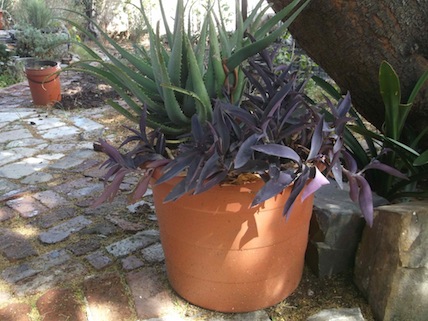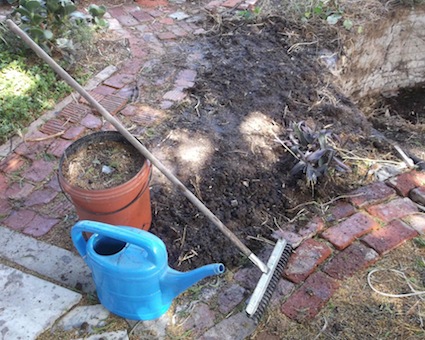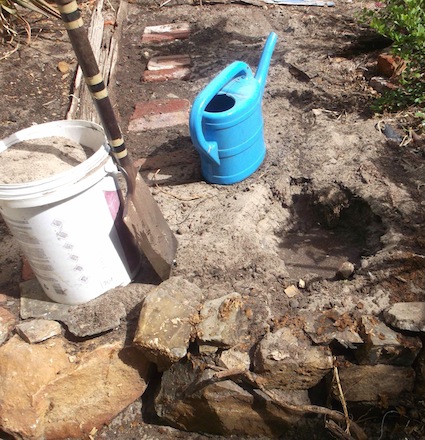Dear Reader, in this age of AI created content, please support with your goodwill someone who works harder to provide the human-made. Sign up at the top of the lefthand column or bottom of this page. You will receive my hand illustrated monthly newsletter RESTORE NATURE and access to the biodiversity garden design course as I write...and nothing else, I respect your time. I am also removing the advertizing as best I can as its become intrusive inappropriate and pays me nothing.
the backyard garden project
stage 4
Referring back to the garden plan for my backyard garden, before the north side of the garden can be planted, which is right of the big curved path labeled 'brick' above on the
plan, some transplanting is needed. Firstly, I needed to move the philodendrons to some pots in the shade. To get the pots empty for the philodendrons, I had to plant out the aloes and the purple wandering jew in the pot. The purple is going in the triangle between the two paths on the plan, and the aloe in a sunny spot near the other aloe, as they are desert plants really, not shade plants.
The wandering jew was planted as one mass, as I couldn’t separate the plant, despite its size, without tearing it. I wanted to minimize its trauma, so that it soon flourishes and covers this area of the backyard garden.
With this plant, and the one from the previous pot, and all the ones I’ve been growing on the window sill in a bucket of water I planted up the triangle. These snapped off purple shoots had taken only a few weeks to root. The shoots seem to fall off naturally when you touch the plant and I gathered all those which had fallen off during transplanting and put them straight in the soil.
All in all there were about ten plants in this small area, and they cover quite a lot of space so the area will hopefully be covered soon. I left a few I’d potted up a while back for the edging of the chill pit which would be planted up at a later stage.
I removed the grass, laid a blanket of vermicastings, of which I’ve an ample supply, being part of a worm farmer couple of long standing.
Then I watered the bed, planted the wandering jew and mulched with dead grass, and scattered thorny branches to prevent my dog squatting and scratching in the area before the plants are established.
This doesn’t seem to work very well, my fluffy darling has graduated from strawberry and salvia destruction to become a purple plant patch decorator in the interim.
The aloe was then free to transplant. It had done surprising well in the shade, developing these amazing sulphur coloured roots which if not coiled up in the pot, must have been metres long. These grew in a few months.
I had previously removed the huge knot of creepers, then I restored the tumbled down foot trodden wall, and made a hole for the aloe where the creepers had been. I filled the
hole with water and let it soak in as this sand resists water penetration. It is old dune sand which has blown far inland and become coated with a fine film of plant resins from the numerous fires which occurred here in summer since before colonization even, and after. A lot of sand in the cape is like this. The water beads on its surface.
I planted the aloe and made a small berm around it and it looks happy in the company of the other aloe.

------
home page for more green links
------
links to other gardening topics
-------
backyard garden project stage 1: measuring up
------
backyard garden project stage 2: planning
------
backyard garden project stage 3: the first aloe pot
------
stage 5 backyard garden project, a simple garden path and planting for shade
Restore Nature Newsletter
I've been writing for four years now and I would love to hear from you
Please let me know if you have any questions, comments or stories to share on gardening, permaculture, regenerative agriculture, food forests, natural gardening, do nothing gardening, observations about pests and diseases, foraging, dealing with and using weeds constructively, composting and going offgrid.
SEARCH
Order the Kindle E-book for the SPECIAL PRICE of only
Prices valid till 30.09.2023
Recent Articles
-
garden for life is a blog about saving the earth one garden at a time
Apr 18, 25 01:18 PM
The garden for life blog has short articles on gardening for biodiversity with native plants and regenerating soil for climate amelioration and nutritious food -
Cape Flats Sand Fynbos, Cape Town's most endangered native vegetation!
Apr 18, 25 10:36 AM
Cape Flats Sand Fynbos, a vegetation type found in the super diverse Cape Fynbos region is threatened by Cape Town's urban development and invasive alien plants -
Geography Research Task
Jan 31, 25 11:37 PM
To whom it may concern My name is Tanyaradzwa Madziwa and I am a matric student at Springfield Convent School. As part of our geography syllabus for this
"How to start a profitable worm business on a shoestring budget
Order a printed copy from "Amazon" at the SPECIAL PRICE of only
or a digital version from the "Kindle" store at the SPECIAL PRICE of only
Prices valid till 30.09.2023














